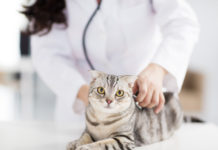I have a cat with a fawn-colored body, a little white on the chest, dark ears and tail, and blue eyes. She looks a lot like a Siamese. But I know my cat is NOT a Siamese because I saw her calico mother! How can a Siamese-looking cat turn up from a calico mother?
Siamese cats, along with a number of other “pointed” breeds – named for the darker color on their points (ear flaps, tail, feet, etc.) – are partial albinos, and the full coat color is expressed only on cooler body surfaces. Recall from high school biology that dominant and recessive genes determine various physical traits – in this case, feline coat color and pattern. The full color gene,
C, is dominant to the Siamese pointed gene, cs, a recessive gene. For a cat to be pointed, it must have two of these recessive genes at the appropriate location on a chromosome (designated cs cs): one gene from Mom and one from Dad. Because the mommy cat demonstrated full color, genetically she was C cs; the dominant C overrode any influence of cs and she displayed no hint of pointing. Your cats father may have been a pointed cat (genetically cs cs), or he, too, may well have been full-color like Mom. Nevertheless, your cat received one cs gene from her mom and another from her dad, so genetically shes cs cs and, therefore, pointed. ———-
I have a two-year-old cat, and in his bed or wherever he lies, he leaves little things that look like sesame seeds. I dont know if its kitty litter or what. He always scratches, but I checked for fleas and found none. Could this all be related? Skin allergies, maybe?
There arent many problems Im able to diagnose from a simple description in a letter, but I think I have this one nailed. The little sesame seed-like structures are, more than likely, dried tapeworm segments. Itching is consistent with a diagnosis of tapeworm infection, too, and I wouldnt be too hasty in ruling out fleas as the cause of your cats scratching.
“Eeew, thats gross!”
If youd seen these “sesame seeds” before they dried, you might have been shocked by their appearance. When fresh, the structures (called proglottids) move like amoeba, and are usually found on freshly eliminated feces or slowly slithering around on the fur or whatever the cat happens to be lying on at the time. Back in the days when I practiced emergency medicine, I often received late night calls from panicked cat owners who, after seeing a proglottid or two on their cat, were simply appalled and couldnt believe that something so disgusting could have come out of their cat. In spite of my counsel to the contrary, they believed their cats life was in immediate danger and insisted on rushing the hapless creature to the clinic for immediate treatment. Fresh tapeworm proglottids are disgusting-looking things, even to most of the veterinary parasitologists I know, but tapeworm infections rarely cause serious health problems. The flea/tapeworm connection
The likely culprit in your cats case is Dipylidium caninum, the most common tapeworm that infects cats and dogs in the United States. Firmly attached to the lining of a cats intestinal tract are tapeworm “heads” from which ever-lengthening chains of proglottids form, much like one might string beads on a necklace. Periodically, proglottids break free from the end of the chain and pass from the anus. Proglottids are little more than packets filled with tapeworm eggs, and when a dried packet breaks open, many eggs are released. Larvae from fleas that have taken up residence on an infected cat then eat the eggs, and the Dypilidium tapeworm completes another phase of its life cycle within the flea. (Fleas are called intermediate hosts, and they are necessary for tapeworms to complete their development.) Cats subsequently become infected while grooming, by inadvertently consuming tapeworm-infected fleas that have infested them. Interestingly, a cat cant become infected if it eats a proglottid; it must consume a tapeworm-infected flea.Treatment: a two-pronged approach
Your veterinarian can prescribe or administer medication to rid your cat of the tapeworms, but unless you deal with the fleas, too, the tapeworms will likely return. Because your cat is itchy, my guess is that your cat still has fleas, although tapeworms can persist even after fleas are eliminated. Fleas can sometimes be hard to see, and your veterinarian may need to help you know for sure. Freeing a cat from fleas may be difficult, usually requiring treatment of both the cat and its environment. Again, seek your veterinarians assistance. But definitely make sure to treat the tapeworms AND the fleas. Otherwise, youll continue to see sesame seeds and slithering segments.



